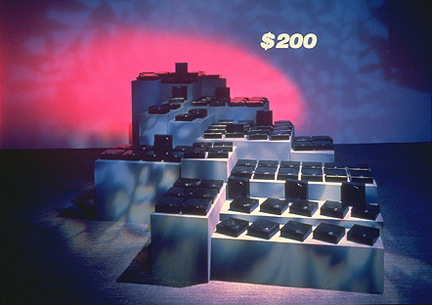|
|
 |
 |
|
|

Allan McCollum, Louise Lawler. Ideal Settings: For Presentation and Display, 1983/84. Around one hundred objects by Allan McCollum and Louise Lawler: wax and shoe polish on cast pigmented Hydrostone, 9 x 9 x 21/4 inches each. Installation designed by McCollum and Lawler, with theatrical lighting and sales price projected on wall, at the Diane Brown Gallery, New York, 1984.
|
For Presentation and Display
Some Art of the 80s
Exhibition Dates: March 19,
2005 through June 12,
2005
The exhibition For Presentation and Display: Some Art of the '80s presents work by a number of influential artists who, working at a moment when commodity culture was seen as accelerating exponentially, became critically engaged in thinking about how images are presented, displayed, and received. It will be on view at the Princeton University Art Museum from March 19 through June 12, 2005. Selected largely from the museum's permanent collection, this exhibition does not aim to present a neat survey of a period, nor does it claim to have found the golden thread uniting work by the nearly twenty artists—including Louise Lawler, Richard Prince, and Cindy Sherman represented. The intention, rather, is to provide a space for reflection upon recent art, now distanced from us by two decades, at the moment it has begun to enter art history books. Works by artists as seemingly diverse as Allan McCollum and Sherrie Levine reveal an attentiveness to the ways in which images (and things) are circulated, "owned," and understood. James Casebere and James Welling play within the parameters of photography, revealing phantasmatic space within an ostensibly objective representational medium. Laurie Simmons and Sarah Charlesworth produce lush feminist imagery that playfully points up the inherently gendered subtext of imagery at large. While the politics of representation are broached in one way or another by each of the artists included in this exhibition, such considerations—utilized less as the overt "content" of works than as subtly implicated contexts for them—vary wildly in their effects, both aesthetic and ideological. It is the artists' shared intuition to explore the functions of images—and the discrete ways in which they do so—that continue to compel interest today. "The exhibition will be of interest to anyone wishing to gain a better understanding of contemporary art, and the broad thematic structure of the presentation will prompt a wider discussion of art's intersection with culture—both 25 years ago and now," says the curator, Johanna Burton, who also has prepared the accompanying brochure and organized a related symposium, "Working Through the '80s," to be held on Saturday, April 14, 2005.
|
 |
|
|